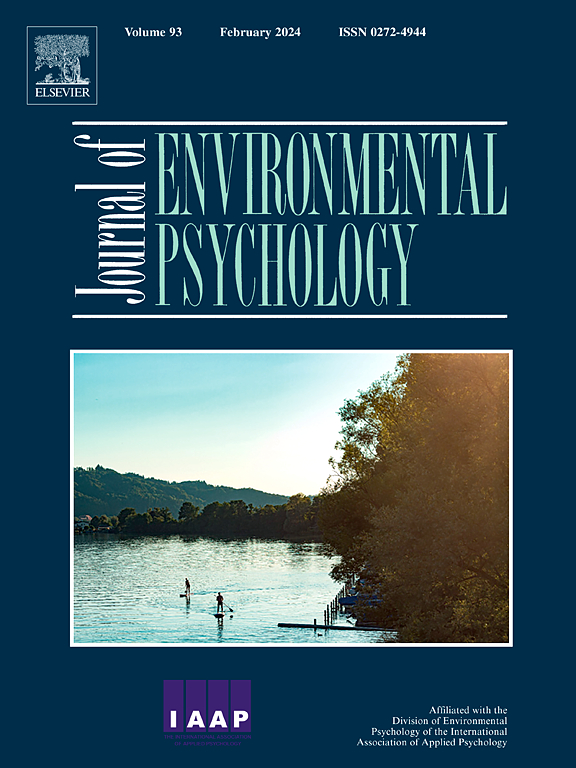Home environments in an age of precarity
IF 6.1
1区 心理学
Q1 ENVIRONMENTAL STUDIES
引用次数: 0
Abstract
Environment-behavior research prior to the 2000s often portrayed homes as relatively self-contained, insular settings that provided residents refuge from the demands and distractions of the outside world—a kind of safe haven for domestic activities and family life. Residential security was viewed largely in relation to personal assets and the nearby environment, including one's capacity to afford high quality housing, defensible space design of the dwelling, and the absence of nearby threats such as fire and flood hazards, seismic risks, and undesirable land uses like oil drilling sites, landfills, and congested roadways. These proximal sources of residential precarity still play a role in people's lives, but their impacts on people are amplified nowadays by a variety of increasingly pervasive threats situated at societal and global levels such as climate change and extreme weather events, disease pandemics, rampant cybercrime, and growing worries about the spread of nuclear weapons. Also, the modern home has become a polyfunctional hub for both household and non-domestic activities, owing to the infusion of work, educational, and recreational activities into residences via their online connections to the outside world. We offer a social ecological analysis of the changing meanings and functions of home environments in the early 21st Century, and a conception of domestic precarity that highlights its links to broader existential concerns driven by societal and global forces. Future policies and environmental interventions to effectively curb residential precarity will require collaboration among individuals from multiple fields and between diverse organizations and institutions working at municipal, state, national and international levels.
不稳定时代的家居环境
2000 年代以前的环境行为研究通常将住宅描绘成相对独立、与世隔绝的环境,为居民提供躲避外界需求和干扰的避难所--一种家庭活动和家庭生活的安全避风港。住宅安全在很大程度上与个人资产和附近环境有关,包括个人负担高质量住房的能力、住宅的可防御空间设计,以及附近是否存在火灾和洪水危险、地震风险等威胁,以及石油钻井地点、垃圾填埋场和拥堵道路等不良土地用途。这些住宅不稳定的近端来源仍然在人们的生活中发挥作用,但如今,气候变化和极端天气事件、疾病流行、猖獗的网络犯罪以及对核武器扩散的日益担忧等各种日益普遍的社会和全球层面的威胁扩大了它们对人们的影响。此外,由于工作、教育和娱乐活动通过网络与外部世界相连,现代家庭已成为家庭和非家庭活动的多功能中心。我们对 21 世纪初家庭环境不断变化的意义和功能进行了社会生态学分析,并提出了家庭不稳定性的概念,强调其与社会和全球力量驱动的更广泛生存问题之间的联系。未来有效遏制住宅不稳定的政策和环境干预措施将需要来自多个领域的个人以及在市、州、国家和国际层面工作的不同组织和机构之间的合作。
本文章由计算机程序翻译,如有差异,请以英文原文为准。
求助全文
约1分钟内获得全文
求助全文
来源期刊

Journal of Environmental Psychology
Multiple-
CiteScore
10.60
自引率
8.70%
发文量
140
审稿时长
62 days
期刊介绍:
The Journal of Environmental Psychology is the premier journal in the field, serving individuals in a wide range of disciplines who have an interest in the scientific study of the transactions and interrelationships between people and their surroundings (including built, social, natural and virtual environments, the use and abuse of nature and natural resources, and sustainability-related behavior). The journal publishes internationally contributed empirical studies and reviews of research on these topics that advance new insights. As an important forum for the field, the journal publishes some of the most influential papers in the discipline that reflect the scientific development of environmental psychology. Contributions on theoretical, methodological, and practical aspects of all human-environment interactions are welcome, along with innovative or interdisciplinary approaches that have a psychological emphasis. Research areas include: •Psychological and behavioral aspects of people and nature •Cognitive mapping, spatial cognition and wayfinding •Ecological consequences of human actions •Theories of place, place attachment, and place identity •Environmental risks and hazards: perception, behavior, and management •Perception and evaluation of buildings and natural landscapes •Effects of physical and natural settings on human cognition and health •Theories of proenvironmental behavior, norms, attitudes, and personality •Psychology of sustainability and climate change •Psychological aspects of resource management and crises •Social use of space: crowding, privacy, territoriality, personal space •Design of, and experiences related to, the physical aspects of workplaces, schools, residences, public buildings and public space
 求助内容:
求助内容: 应助结果提醒方式:
应助结果提醒方式:


